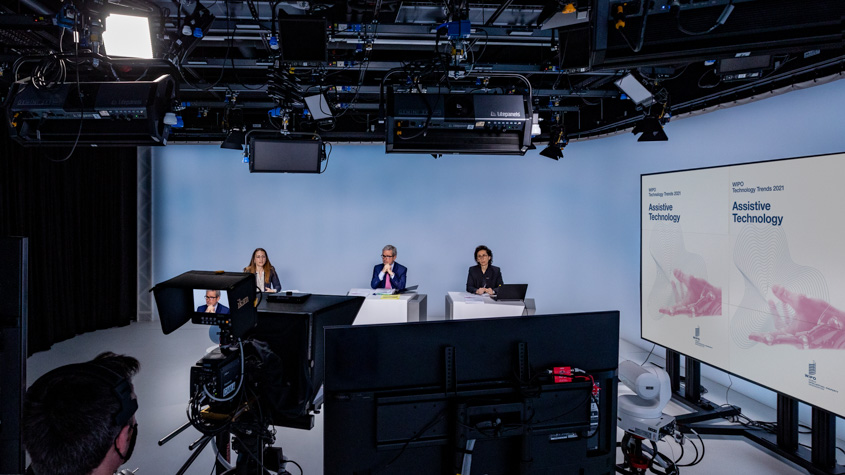WIPO Report Finds Significant Growth in Assistive Technologies as they Find Greater Application in Consumer Goods
Geneva,
March 23, 2021
PR/2021/875
Innovations that help people overcome mobility, sight and other disabilities have seen double-digit growth in recent years and these “assistive technologies" are increasingly integrated with consumer goods, a new WIPO report shows.
Press release available for download in Japanese and Portuguese
According to the WIPO Technology Trends Report 2021: Assistive Technologies, over 1 billion people currently need assistive technology - a figure expected to double in the next decade as populations age. At the same time, consumer electronics and assistive products are converging, meaning even greater commercialization of these technologies.
The report shows that innovations, ranging from small improvements in existing products to cutting-edge developments in frontier technologies, can greatly improve the lives of persons with functional limitations. These technologies help them overcome daily obstacles in navigating their environments, communicating, working and living independently.
The report uses patent and other data to provide solid, factual evidence on innovation in the global assistive tech landscape, creating a knowledge base to inform and support business leaders, researchers and policy-makers in their decision-making. It finds that China, the U.S., Germany, Japan and the Republic of Korea are the five main origins of innovation in assistive technology.
“Assistive technologies designed to overcome human limitations are now heading to a wider range of consumer products, marking an important innovation evolution with big benefits for a wider range of people," said Assistant Director General Marco Aleman who oversees WIPO’s IP and Innovation Ecosystems Sector. "For example, devices with brain-machine interface or eye movement recognition that help people with cerebral palsy use computing devices can also be employed in gaming and communication applications. It is very good news that these life-improving technologies are heading toward mainstream commercialization, while also benefiting those who need them most.”
Key findings
Report findings include:
- The Tech Trends report identified more than 130,000 patents related to conventional and emerging assistive technologies published between 1998 and mid 2020, with 15,592 filings on emerging assistive technologies alone in the period.
- Filings in emerging assistive technology - including assistive robots, smart home applications, wearables for visually impaired and smart glasses - have grown three times faster (17% average annual growth rate, or AAGR, during the period 2013-2017 for first filing, with the publication of patent applications occurring 18 or more months later) than in conventional assistive technology. Innovations in conventional technologies include improvements and accessories of well-established products like wheelchair seats or wheels adjusted for different terrains, environmental alarms and Braille-enabled devices.
- Two fast-growing areas in emerging assistive tech are environment (42% AAGR) and mobility (24% AAGR). Emerging environment technologies include navigation aids in public spaces and assistive robots. Emerging mobility tech includes applications like autonomous wheelchairs and advanced prosthetics.
- The assistive technology field is converging with consumer electronic goods and general medical technologies. Technologies developed for persons with functional limitations are increasingly applied to mainstream products. For example, bone conduction technology that can assist with hearing impairment can also be used in runners' headsets.
- A technology readiness level assessment showed that most emerging assistive technologies are in development phase, while 18% are already commercialized.
- Corporate players are leading the development of assistive technology including specialized assistive tech companies such as WS Audiology, Cochlear, Sonova, Second Sight and Össur. Electronic consumer goods companies (like Panasonic, Samsung, IBM, Google and Hitachi) and car industry companies (Toyota and Honda) are also major players.
- Universities and public research organizations are more prominent in the emerging assistive technology dataset (23% of patent applicants versus 11% in the conventional), and are particularly active in the field of mobility (34% of patent applicants).
The report concludes that intellectual property has enabled the growth in innovation in assistive technologies. Experts contributing to the report underline the need for this innovation to become more widely available for those who rely on it. Globally, only 1 in 10 people currently have access to the assistive products they need. With this publication, WIPO aims to provide the knowledge-base to support global discussions on assistive technology that come under the umbrella of the UN Convention on Rights for People with Disabilities (CRPD) and the work of the World Health Organization (WHO) to promote greater access to assistive technology.

Press conference: Video on YouTube
About the Technology Trends series
The WIPO "Technology Trends" series tracks technology trends through the analysis of patent and other data to provide solid, factual evidence on innovation in specific fields. Expert contributors from different sectors of the innovation ecosystem enrich the reports with their valuable comments and insights, while information about the wider context - policy, standards, regulation, legislation, implications for intellectual property systems - contribute to a more complete picture of the landscape. The resulting knowledge base informs and supports business leaders, researchers and policy-makers in their decision-making. The series is part of WIPO's work creating knowledge products that support a global economic environment where individuals and enterprises of all sizes can more easily bring exciting new products to market.
About WIPO
The World Intellectual Property Organization (WIPO) is the United Nations agency that serves the world’s innovators and creators, ensuring that their ideas travel safely to the market and improve lives everywhere.
We do so by providing services that enable creators, innovators and entrepreneurs to protect and promote their intellectual property (IP) across borders and acting as a forum for addressing cutting-edge IP issues. Our IP data and information guide decisionmakers the world over. And our impact-driven projects and technical assistance ensure IP benefits everyone, everywhere.
For more information, please contact the News and Media Division at WIPO:- Tel: (+41 22) 338 81 61 / 338 72 24
